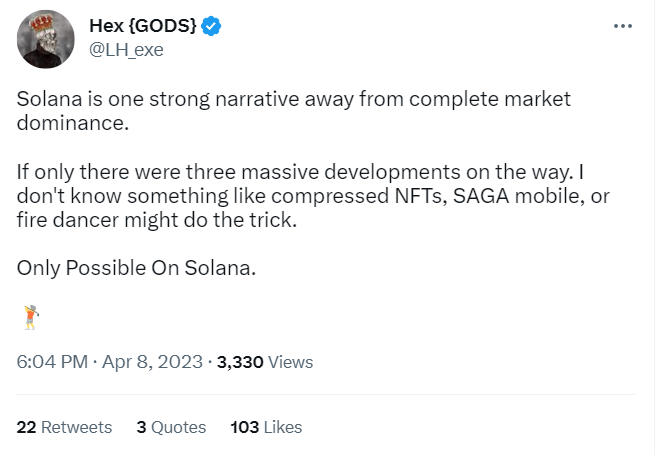Solana’s New State Compression

This blog post will cover:
- What is state compression?
- How does state compression work?
- What was the reaction of the Solana community?
- Conclusion
At the beginning of April 2023, Solana announced an exciting development: the team is launching so-called compressed Non-Fungible Tokens (NFTs). Using the state compressing technology, the developers are going to decrease the cost of storing NFTs on the chain by 2,400-24,000 times.
In this article, we are going to find out what this innovation is and whether it has the potential to revolutionize the blockchain’s work.
What is state compression?
State compression is a technique used in Solana's blockchain network to reduce the amount of data needed to mint and store NFTs. By compressing the state of an NFT, the amount of data stored on the blockchain can be reduced, making transactions faster and cheaper.
Solana's state compression uses Merkle trees to compress the NFT's state into a smaller size without losing any important information or sacrificing security and privacy. State compression is especially useful for large NFT collections, where the size of each individual NFT can quickly add up to a significant amount of data. With state compression, the overall size of the collection can be reduced, allowing for faster and cheaper transactions.
From a comparison made by the Solana team, we can see how with the increased amount of NFTs the technology is becoming progressively more beneficial. For example, minting 1,000 NFTs would be cheaper on Polygon even if we compare it to the compressed state on Solana. However, if the number of NFTs is higher, say, 100 mln, then the cost on Polygon rises to about $3.3 mln, whereas the same amount of compressed NFTs on Solana would only cost approximately $1,200.
How does state compression work?
At the center of this technology is the capability that only exists on the Solana blockchain to simultaneously update Merkle trees many times in the same block. It is possible due to allowing the fast-forwarding of stale proofs.
Additionally, by using a compression-friendly data structure, developers can store a small amount of data on the Solana blockchain and update it directly on the ledger (for instance, if it is necessary to update the metadata or if the owner changed, etc.)
Minting compressed NFTs requires a special tool called Bubblegum. This smart contract was created by Metaplex, an open protocol for NFT creators. Though this does not mean that the minting process became more complicated: it still does not require any proof.
What was the reaction of the Solana community?
A lot of users seem to be very excited about the novelty, with some even admitting to buying SOL tokens just because of the news. They also bring up other achievements like Solana mobiles and Firedancer, the open-source validator client that went live in 2022.
Other users who are more skeptical, raise questions about what happens in case there are issues with the mainnet work. However, the overall attitude seems very positive with lots of users congratulating the Solana team on the update.
Conclusion
From what we have seen already, compressed NFTs have a strong potential to increase Solana’s popularity. In the past few months, the project has had a rough time after the FTX collapse, with some experts even wondering if the blockchain has a future. However, with the recent technological advancements, the Solana team is proving that it is not justified to disregard it.
SimpleSwap reminds you that this article is provided for informational purposes only and does not provide investment advice. All purchases and cryptocurrency investments are your own responsibility.


